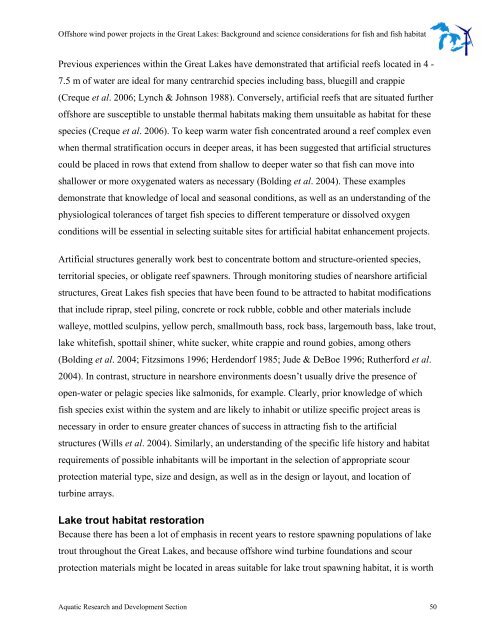Offshore Wind Power Projects in the Great Lakes - Ministry of ...
Offshore Wind Power Projects in the Great Lakes - Ministry of ...
Offshore Wind Power Projects in the Great Lakes - Ministry of ...
You also want an ePaper? Increase the reach of your titles
YUMPU automatically turns print PDFs into web optimized ePapers that Google loves.
<strong>Offshore</strong> w<strong>in</strong>d power projects <strong>in</strong> <strong>the</strong> <strong>Great</strong> <strong>Lakes</strong>: Background and science considerations for fish and fish habitat<br />
Previous experiences with<strong>in</strong> <strong>the</strong> <strong>Great</strong> <strong>Lakes</strong> have demonstrated that artificial reefs located <strong>in</strong> 4 -<br />
7.5 m <strong>of</strong> water are ideal for many centrarchid species <strong>in</strong>clud<strong>in</strong>g bass, bluegill and crappie<br />
(Creque et al. 2006; Lynch & Johnson 1988). Conversely, artificial reefs that are situated fur<strong>the</strong>r<br />
<strong>of</strong>fshore are susceptible to unstable <strong>the</strong>rmal habitats mak<strong>in</strong>g <strong>the</strong>m unsuitable as habitat for <strong>the</strong>se<br />
species (Creque et al. 2006). To keep warm water fish concentrated around a reef complex even<br />
when <strong>the</strong>rmal stratification occurs <strong>in</strong> deeper areas, it has been suggested that artificial structures<br />
could be placed <strong>in</strong> rows that extend from shallow to deeper water so that fish can move <strong>in</strong>to<br />
shallower or more oxygenated waters as necessary (Bold<strong>in</strong>g et al. 2004). These examples<br />
demonstrate that knowledge <strong>of</strong> local and seasonal conditions, as well as an understand<strong>in</strong>g <strong>of</strong> <strong>the</strong><br />
physiological tolerances <strong>of</strong> target fish species to different temperature or dissolved oxygen<br />
conditions will be essential <strong>in</strong> select<strong>in</strong>g suitable sites for artificial habitat enhancement projects.<br />
Artificial structures generally work best to concentrate bottom and structure-oriented species,<br />
territorial species, or obligate reef spawners. Through monitor<strong>in</strong>g studies <strong>of</strong> nearshore artificial<br />
structures, <strong>Great</strong> <strong>Lakes</strong> fish species that have been found to be attracted to habitat modifications<br />
that <strong>in</strong>clude riprap, steel pil<strong>in</strong>g, concrete or rock rubble, cobble and o<strong>the</strong>r materials <strong>in</strong>clude<br />
walleye, mottled sculp<strong>in</strong>s, yellow perch, smallmouth bass, rock bass, largemouth bass, lake trout,<br />
lake whitefish, spottail sh<strong>in</strong>er, white sucker, white crappie and round gobies, among o<strong>the</strong>rs<br />
(Bold<strong>in</strong>g et al. 2004; Fitzsimons 1996; Herdendorf 1985; Jude & DeBoe 1996; Ru<strong>the</strong>rford et al.<br />
2004). In contrast, structure <strong>in</strong> nearshore environments doesn’t usually drive <strong>the</strong> presence <strong>of</strong><br />
open-water or pelagic species like salmonids, for example. Clearly, prior knowledge <strong>of</strong> which<br />
fish species exist with<strong>in</strong> <strong>the</strong> system and are likely to <strong>in</strong>habit or utilize specific project areas is<br />
necessary <strong>in</strong> order to ensure greater chances <strong>of</strong> success <strong>in</strong> attract<strong>in</strong>g fish to <strong>the</strong> artificial<br />
structures (Wills et al. 2004). Similarly, an understand<strong>in</strong>g <strong>of</strong> <strong>the</strong> specific life history and habitat<br />
requirements <strong>of</strong> possible <strong>in</strong>habitants will be important <strong>in</strong> <strong>the</strong> selection <strong>of</strong> appropriate scour<br />
protection material type, size and design, as well as <strong>in</strong> <strong>the</strong> design or layout, and location <strong>of</strong><br />
turb<strong>in</strong>e arrays.<br />
Lake trout habitat restoration<br />
Because <strong>the</strong>re has been a lot <strong>of</strong> emphasis <strong>in</strong> recent years to restore spawn<strong>in</strong>g populations <strong>of</strong> lake<br />
trout throughout <strong>the</strong> <strong>Great</strong> <strong>Lakes</strong>, and because <strong>of</strong>fshore w<strong>in</strong>d turb<strong>in</strong>e foundations and scour<br />
protection materials might be located <strong>in</strong> areas suitable for lake trout spawn<strong>in</strong>g habitat, it is worth<br />
Aquatic Research and Development Section 50
















